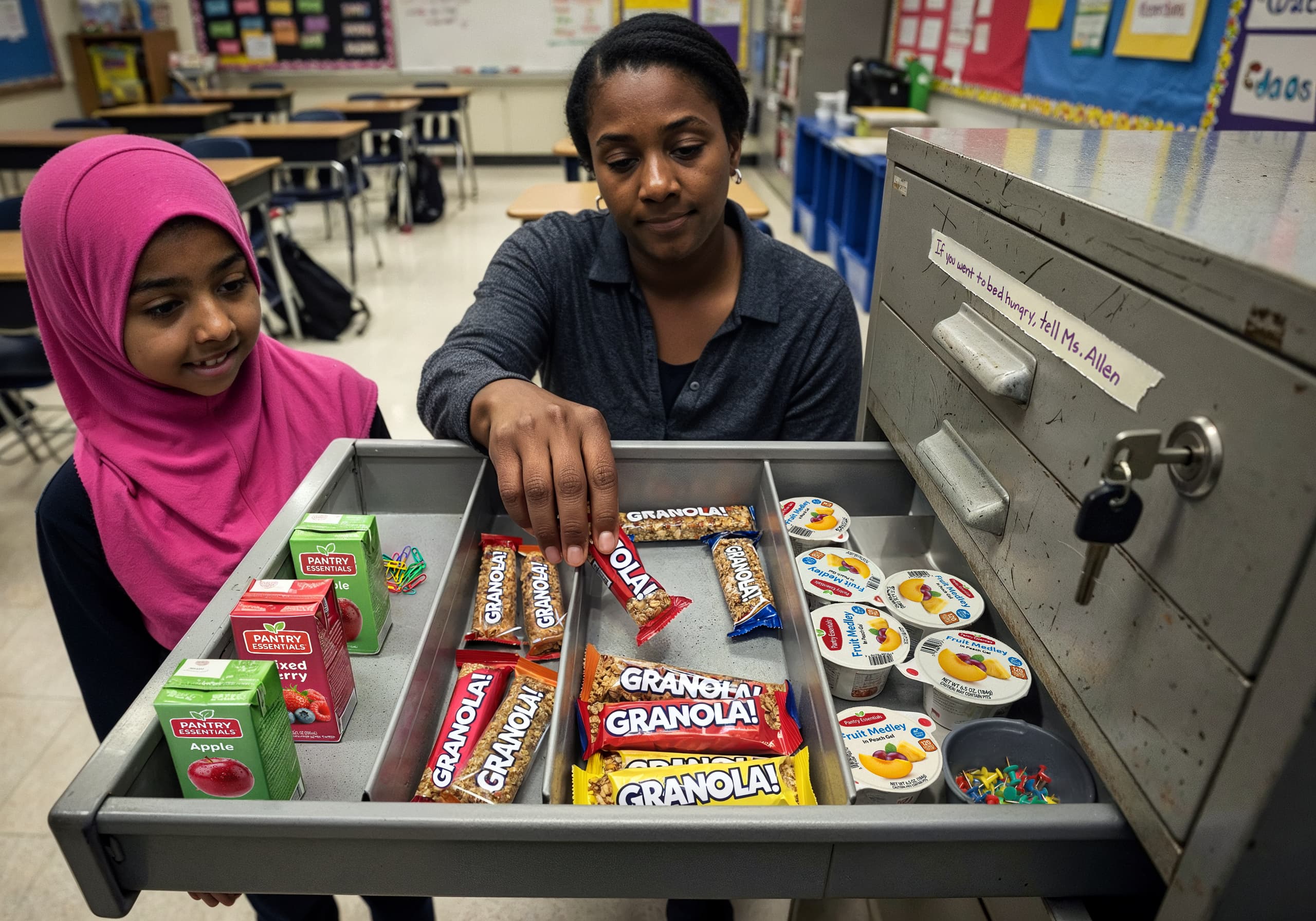
Los Angeles, California. October 22, 2027
Second-grade teacher Kendra Allen unlocks the classroom’s “secret snack safe,” a constantly dwindling pantry she stocks out-of-pocket for children like Maya who arrive too hungry to focus. Teachers nationwide report a surge in student hunger just as the One Big Beautiful Bill’s changes to food assistance begin to take effect. Many families have already lost some or all of their SNAP benefits, and, by 2034, projections show 2.7 million families with children will be affected. As households fall off SNAP, kids also lose automatic eligibility for free or reduced-price school meals, requiring parents to apply on their own—a “double whammy” contributing to deepening child hunger in every state.
Sources
- "By the Numbers: Harmful Republican Megabill Takes Food Assistance Away From Millions" — Center on Budget and Policy Priorities, July 2025
- "How Trump’s sweeping tax and domestic policy bill will affect children and schools" — Chalkbeat, July 3, 2025
- "What Trump’s budget and tax law means for California students" — EdSource, July 7, 2025
- "One Big Beautiful Bill Act Fails Students and Our Education System" — New America, July 3, 2025

Jacksonville, North Carolina. April 11, 2027
Shane Castillo, a Marine veteran, struggles with basic tasks while getting ready for another early-morning rideshare shift. After the One Big Beautiful Bill ended the veterans’ exemption from SNAP’s work requirement, Castillo—still dealing daily with physical and mental injuries he suffered in Afghanistan—must now document 80 hours each month to keep his family’s benefits. Of the estimated 1.2 million veterans receiving food assistance, disabled working-age veterans like Castillo face the highest rates of food insecurity—33.6 percent—a share likely to rise as more injured veterans find the 80-hour requirement impossible to meet month after month.
Sources
- "2025 Budget Impacts: House Bill Would Cut Assistance and Raise Costs for Veterans" — Center on Budget and Policy Priorities, June 9, 2025
- "‘We won’t be able to make ends meet’: Congress proposes tighter rules for food assistance for veterans Stars and Stripes, June 30, 2025
- "Food Insecurity Among Working-Age Veterans" — USDA Economic Research Service, May 2021
- "House sends Trump megabill with $150B boost to defense, tighter rules for food aid for veterans" — Stars and Stripes, July 3, 2025
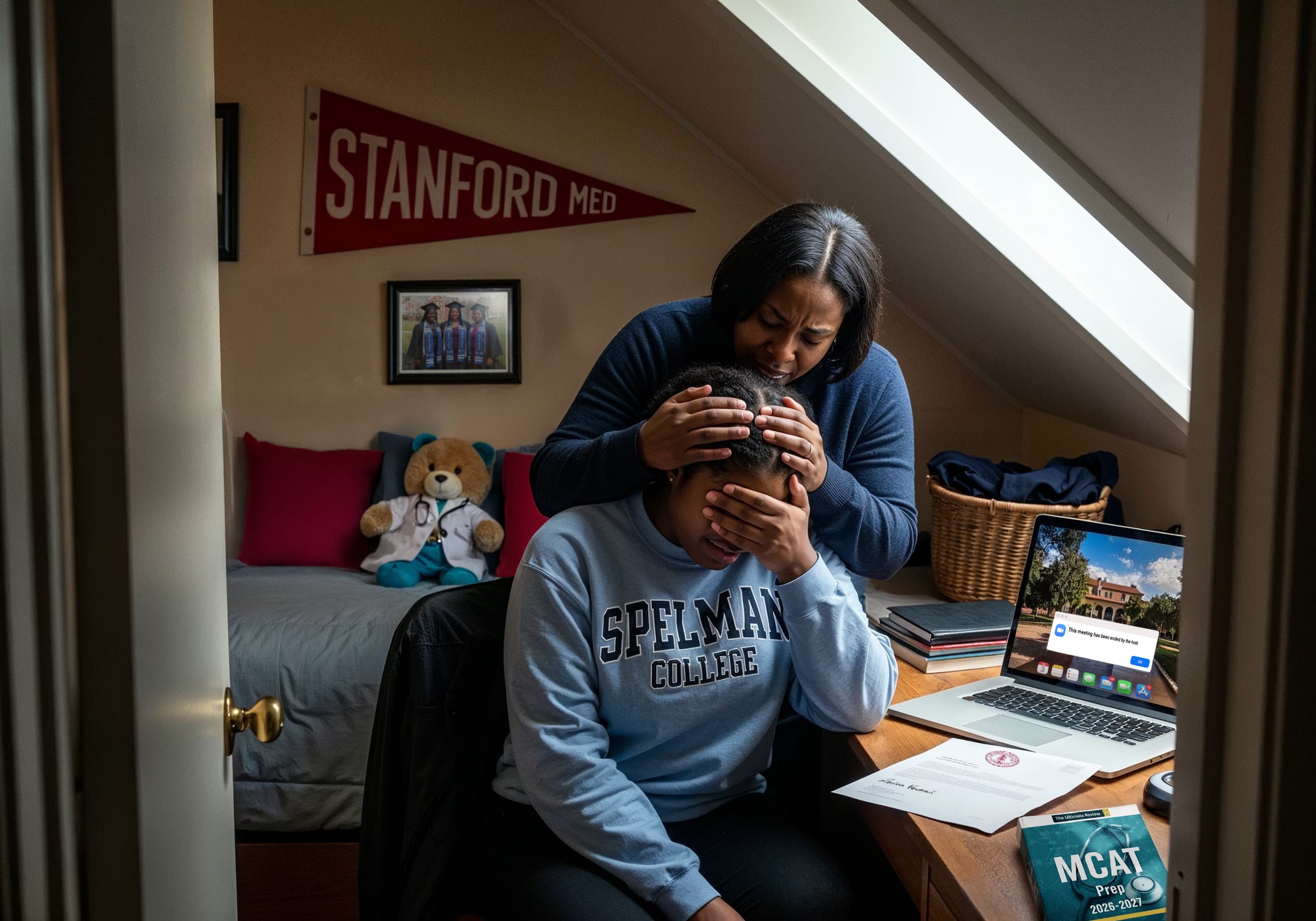
Baltimore, Maryland. May 7, 2026
Keisha Freeman, a Spelman College senior, reacts to the letter that accepts her to Stanford Medical School—and informs her that her financial aid package still leaves a $140,000 gap. Her dream has collided with a new reality created by the One Big Beautiful Bill: the law eliminated the federal Grad PLUS loan program, which once covered the full cost of attendance, while imposing a $200,000 cap on all graduate borrowing—leaving a typical shortfall ranging from $86,000 for public medical schools and up to $190,000 at private schools, often requiring private loans that many students may not even qualify for. Experts warn the change is pushing the cost of advanced degrees beyond the reach of most students, making the country’s most influential professions the near-exclusive domain of the already wealthy.
Sources
- "Medical Students Fret Over Student Loan Cap in ‘Big Beautiful Bill’" — NBC News, July 5, 2025
- "Republican plans to cap student borrowing could shatter an everyday profession" — Politico, June 21, 2025
- "Proposed Changes to Federal Student Loans Could Worsen Doctor Shortage" — Association of American Medical Colleges (AAMC), June 25, 2025
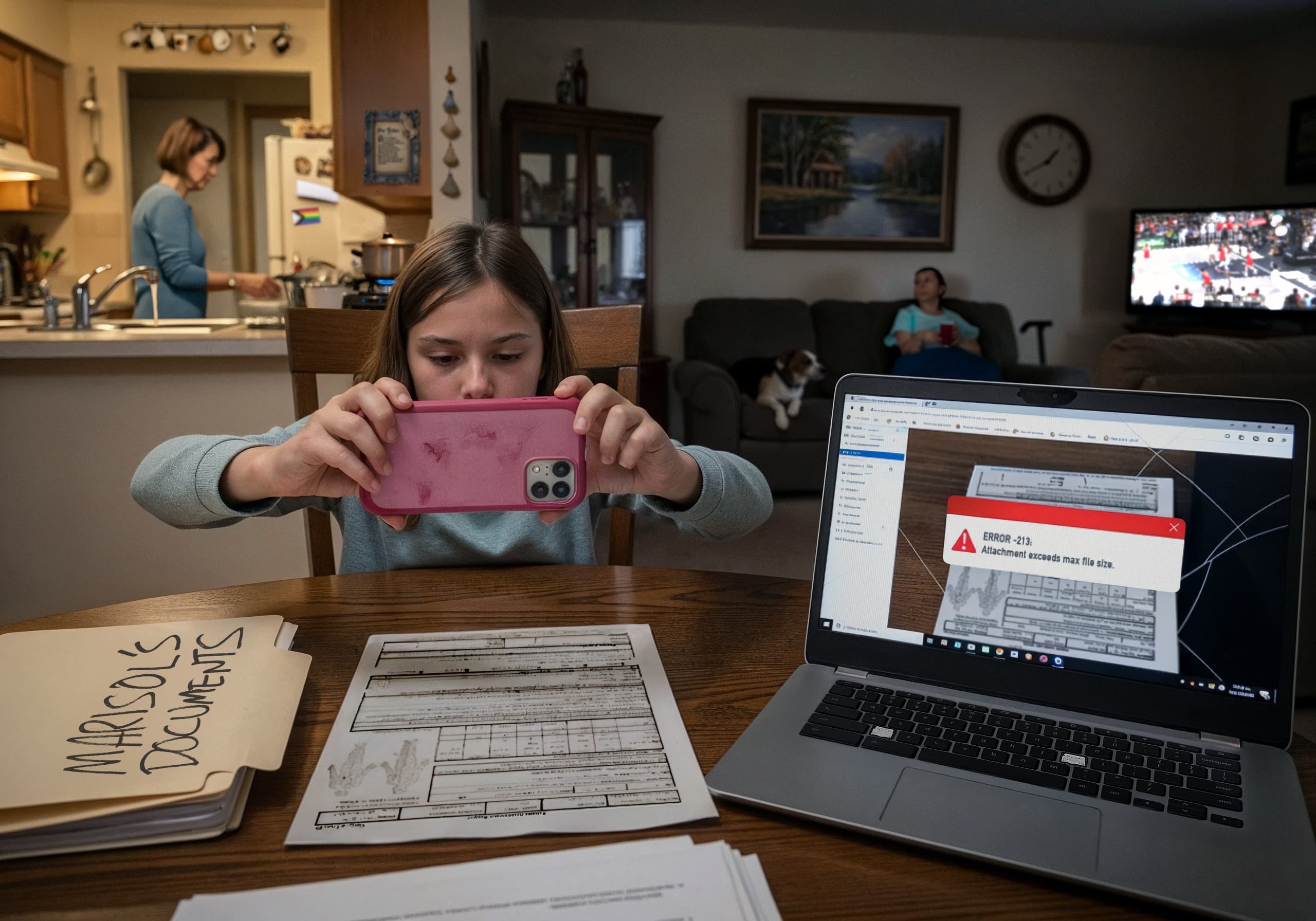
Gainesville, Georgia. September 14, 2028
Nine-year-old Mia Reyes-Johnson tries for the third time to upload a doctor’s evaluation of Marisol’s stroke recovery to the State of Georgia’s glitchy benefits portal. Mia's grandmother, Anita, who provides near-full-time unpaid care for her wife, must now prove she qualifies for a caregiver exemption under Medicaid work requirements expanded up to age 64 by the One Big Beautiful Bill. The law’s new rules—originally sold as targeting young men “playing video games all day”—have instead fallen hardest on women, who make up nearly 80% of non-working Medicaid recipients, and disproportionately on queer women, who rely on Medicaid at roughly twice the national rate.
Sources
- "No proof of work could mean no Medicaid — and women stand to lose the most" — The 19th, May 15, 2025
- "How the G.O.P. Bill Saves Money: Paperwork, Paperwork, Paperwork" — New York Times, June 29, 2025
- "Medicaid and Its Role for Older Adults" — AARP Public Policy Institute, March 2025
- "With fewer protections and more paperwork, LGBTQ+ Americans face a Medicaid coverage cliff" — The 19th, July 15, 2025
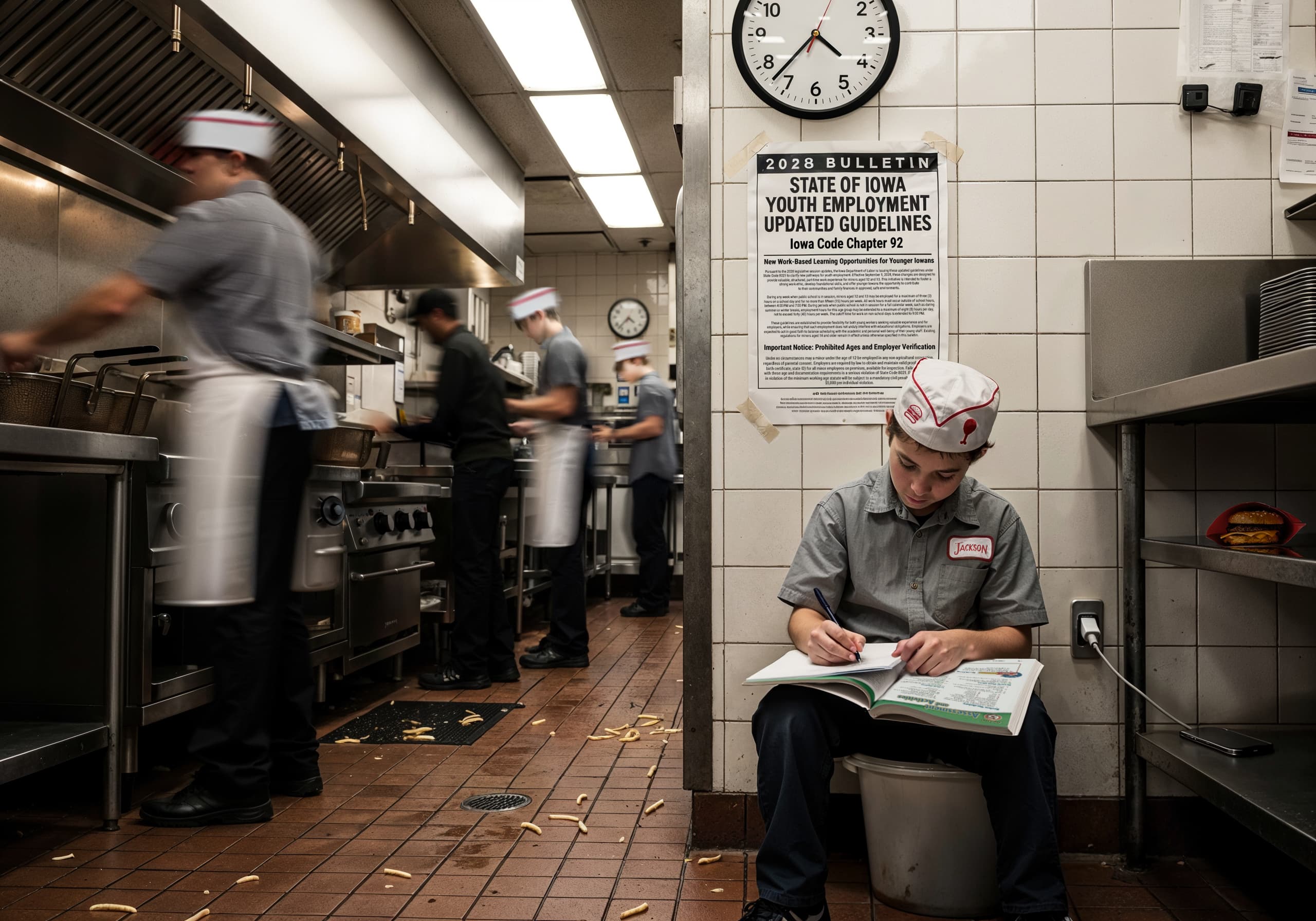
Sioux City, Iowa. May 16, 2029
Ten-year-old Jackson Meyer rushes through homework during a break in his evening shift at 'fast causal' restaurant Hearth & Hubcap, hoping to avoid staying up late after work to finish. His modest paycheck has become essential family income since his mother was forced to quit her job to care for Jackson’s siblings. Like many other states, Iowa has been forced to shift scarce dollars into Medicaid to cover a looming shortfall—$1 billion less in federal Medicaid and SNAP funding, a $1.1 billion drag on the state economy, and $74 million less in tax revenue—resulting in cuts to services like the child-care assistance critical to Jackson’s family. Amid growing economic hardship, Iowa lawmakers recently relaxed youth-employment rules for the second time this decade; with enforcement lax, kids as young as Jackson now staff kitchens across the state.
Sources
- "States Brace for Added Burdens of Trump’s Tax and Spending Law" — New York Times, July 4, 2025
- "How Medicaid and SNAP Cutbacks in the “One Big Beautiful Bill” Would Trigger Big and Bigger Job Losses Across States" — Commonwealth Fund, June 23, 2025
- "Iowa governor signs bill loosening child labor laws" — Associated Press, May 26, 2023
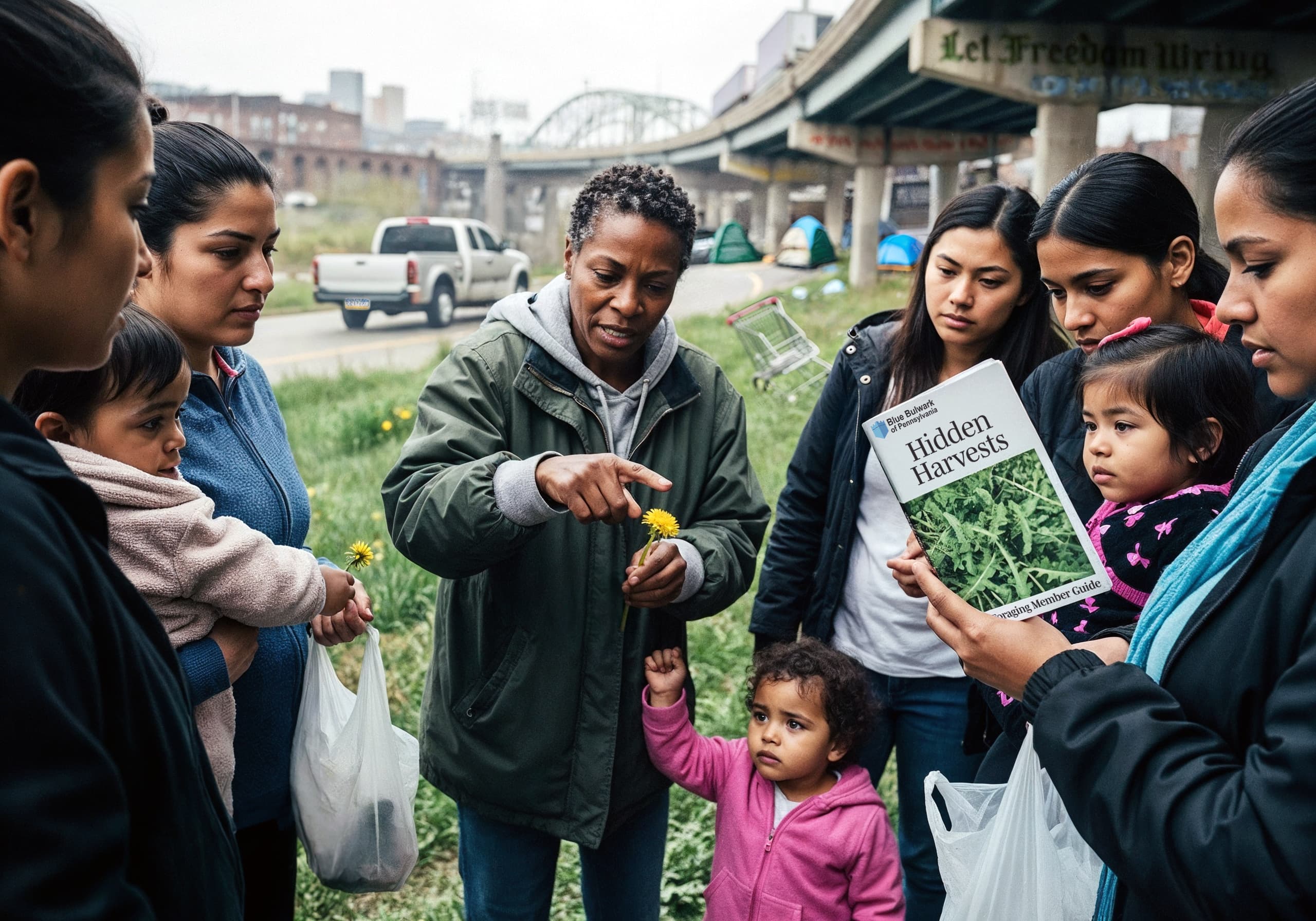
Pittsburgh, Pennsylvania. October 21, 2028
Monique Harris, a community affairs liaison for Blue Bulwark of Pennsylvania, a health insurer, teaches a class on identifying edible wild dandelions and other nutrient-rich weeds to a small group of young mothers anxious for new ways to feed their families. Since the One Big Beautiful Bill cut funding and tightened work requirements for food assistance, tens of thousands of Pennsylvanians have already lost their SNAP benefits, a number expected to rise to 140,000 in the coming years. Critics call workshops like these corporate-sponsored triage: minimal-investment “band-aid” interventions offered now in hopes of heading off years of claims for emergency-room visits, developmental delays, and chronic disease linked to hunger and malnutrition.
Sources
- "Pennsylvania food banks worry about SNAP cuts in federal government's proposed budget bill" — CBS News, June 3, 2025
- "SNAP Is Linked With Improved Health Outcomes and Lower Health Care Costs" — Center on Budget and Policy Priorities, December 14, 2022
- "Food Is Medicine and the Future of Care Delivery" — Food Tank, July, 2025
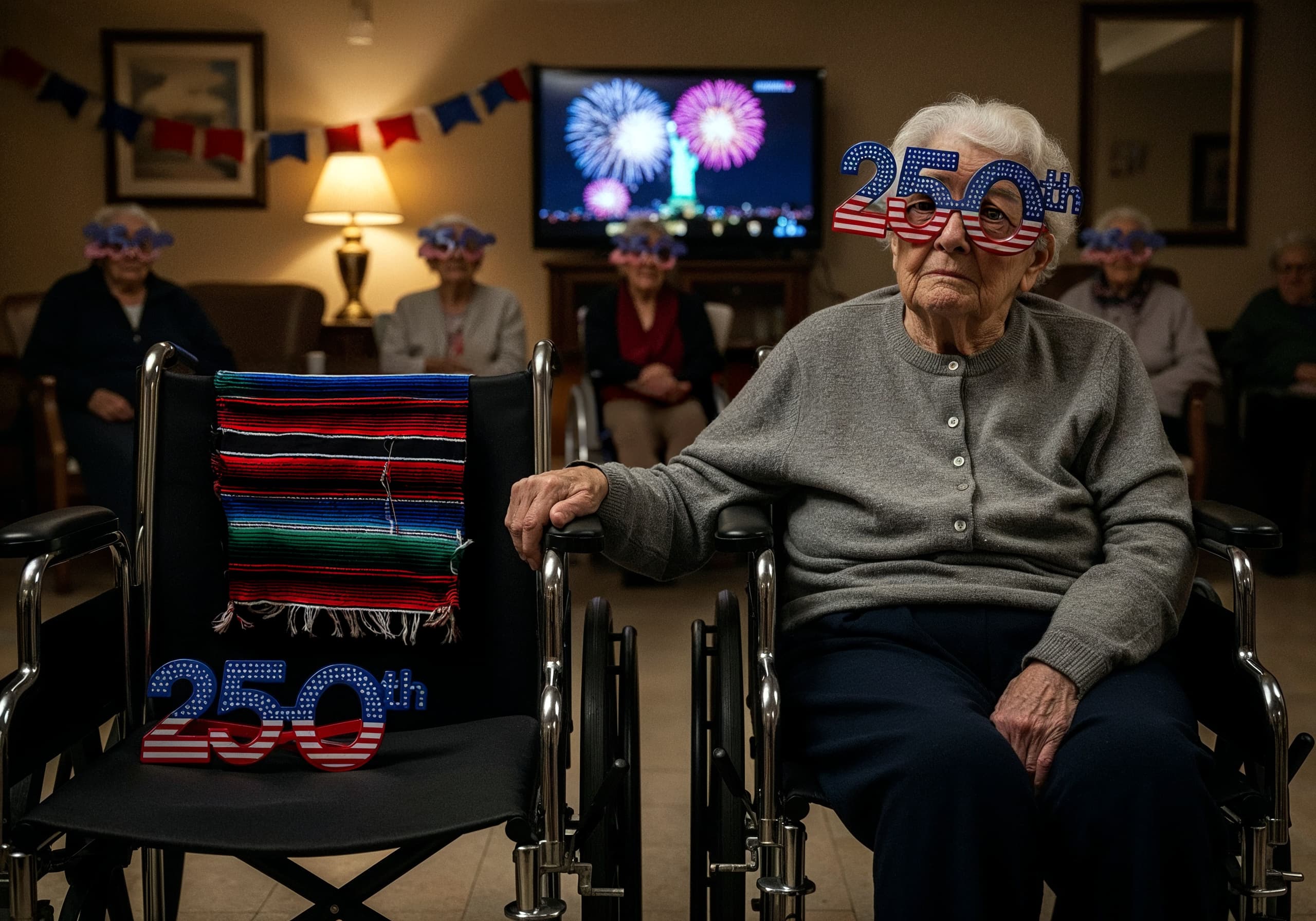
Tulsa, Oklahoma. July 4, 2026
Loretta Lakowski stares past the semiquincentennial fireworks on the rec room television, her gaze drifting to the empty wheelchair where her friend Rosa used to sit. Rosa’s death two months ago from complications after a fall—deemed preventable by the facility and blamed on “critical staffing shortfalls”—has become a tragically common story in long-term care. After the One Big Beautiful Bill cut and capped home- and community-based services, many older adults lost the support helping them stay at home and were pushed into nursing homes. At the same time, the bill’s cuts to Medicaid have left these facilities short-staffed: over half of long-term care providers have cut staff and roughly a quarter have closed beds or entire wings. With the law also delaying a minimum-staffing standard from taking effect, skeleton crews are now routine—the kind of gap cited in Rosa’s fall.
Sources
- "Nursing Home Staffing Mandate Delayed" — AARP, July 23, 2025
- "How Medicaid Cuts Could Force Millions into Nursing Homes" — Leonard Davis Institute of Health Economics at the University of Pennsylvania (Penn LDI), July 2, 2025
- "New Survey Highlights Devastating Impact of Medicaid Reductions on Nursing Homes" — American Health Care Association / National Center for Assisted Living (AHCA/NCAL), June 9, 2025
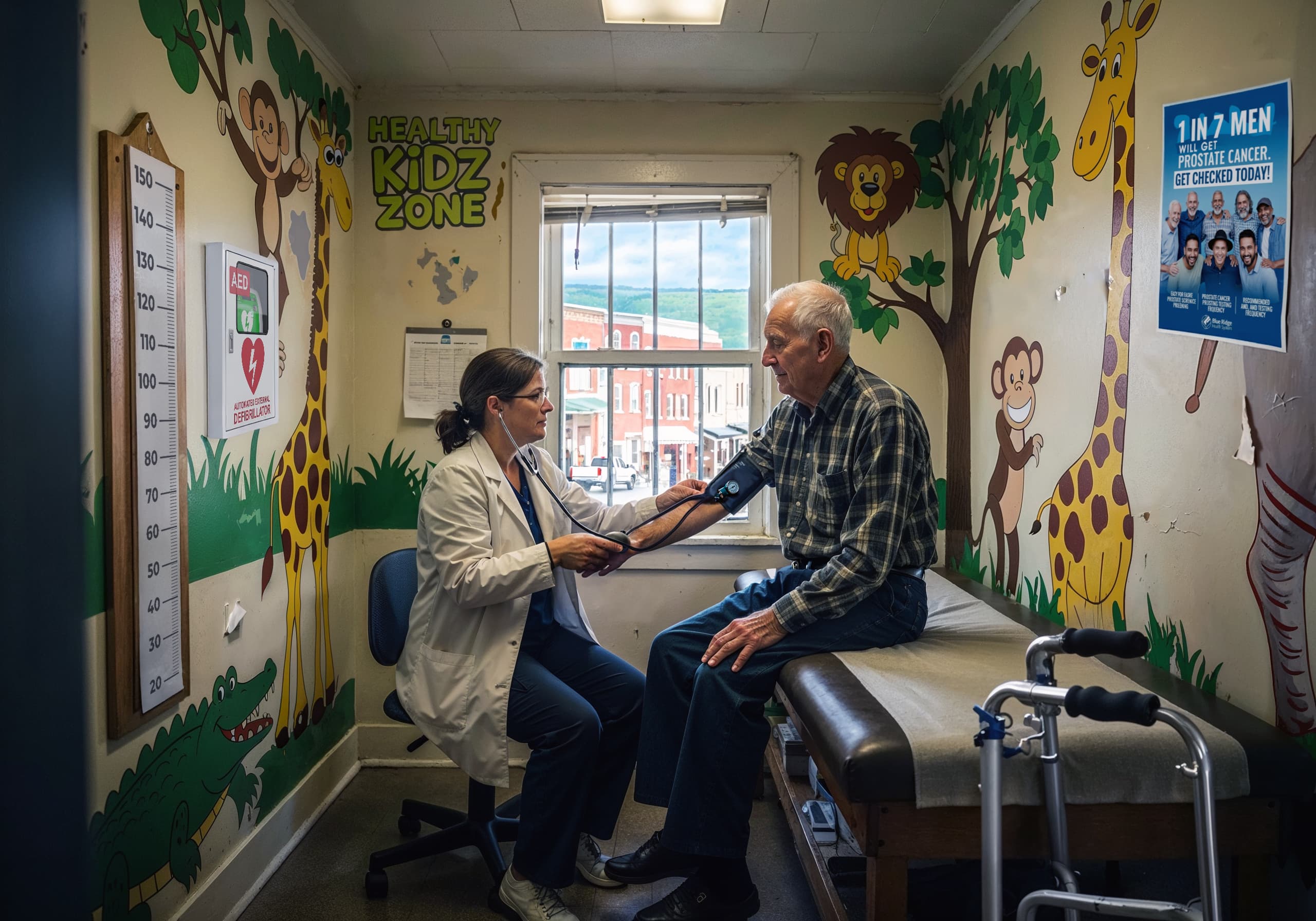
Salmon, Idaho. June 15, 2030
In a room still decorated to soothe young patients, pediatrician Dr. Monica Peña takes the blood pressure of Wayne, who, at 81, is decades older than her former clientele. After cuts to federal Medicaid spending in the One Big Beautiful Bill—estimated to pull about $137 billion from rural communities by 2034—the region’s lone hospital shuttered its low-margin maternity and pediatric units, pushing many parents to move closer to care. Peña's practice has reluctantly shifted to geriatric medicine, serving a town that is older, smaller, and increasingly worried about its survival without the basic health infrastructure needed to attract and keep families.
Sources
- "‘One Big Beautiful Bill’ Would Batter Rural Hospital Finances, Researchers Say" — KFF Health News, June 12, 2025
- "How Massive Medicaid Cuts Will Harm People’s Health" — Scientific American, July 3, 2025
- "Medicaid, CHIP, and Affordable Care Act Marketplace Cuts and Other Health Provisions in the Budget Reconciliation Law, Explained" — Georgetown University Center for Children and Families, July 22, 2025
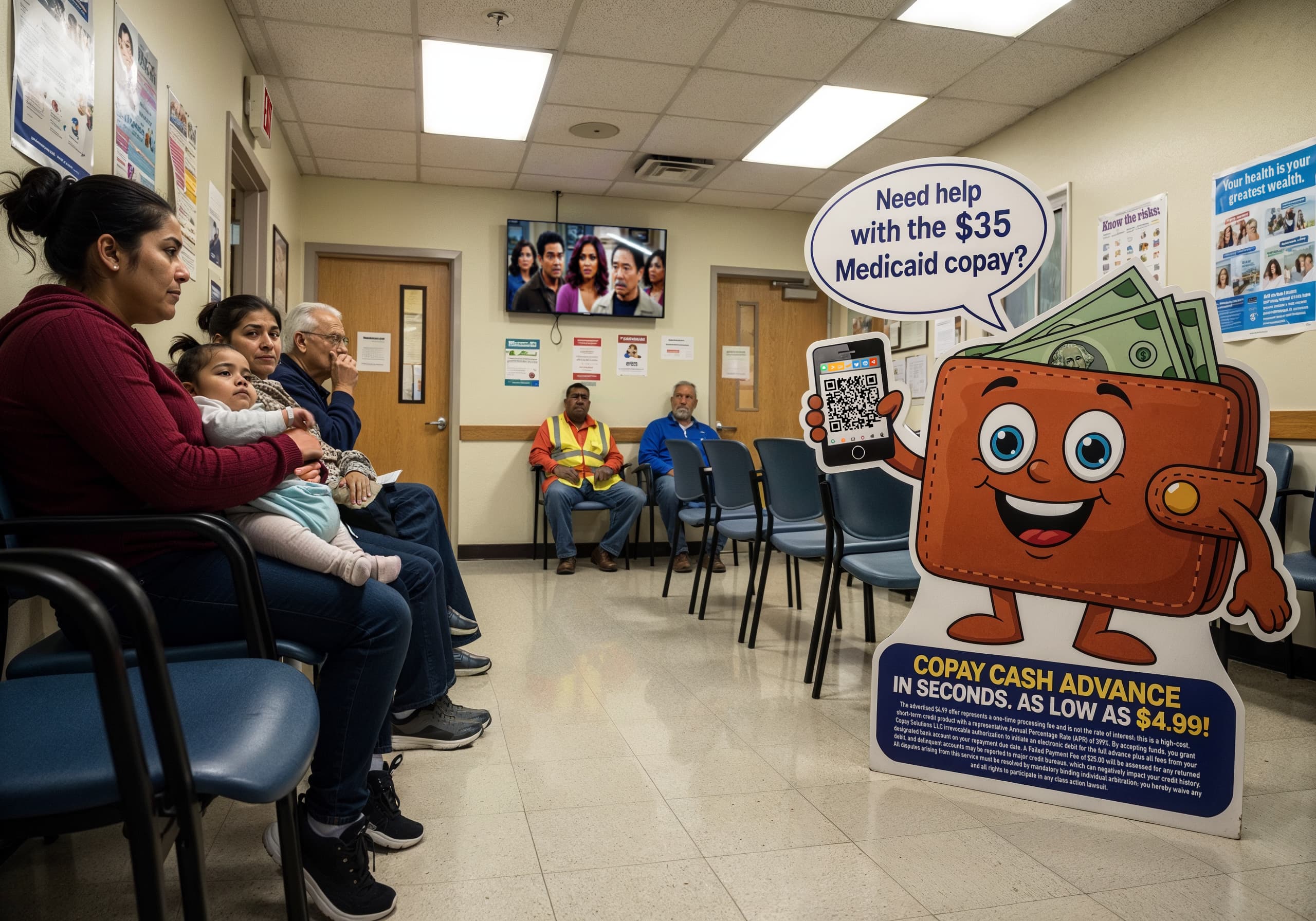
Houston, Texas. February 5, 2031
In waiting rooms across the U.S., advertisements for high-interest “copay loans” and medical credit cards have become a common sight. Under the One Big Beautiful Bill, many Medicaid expansion adults with incomes above the poverty line now face mandatory copays, and states may now allow providers to require payment before delivering many non-emergency services. The new copay requirement has fueled a predatory lending market targeting this already vulnerable group. Public health experts warn that even minimal financial barriers—fees as low as $1—reduce use of care and can worsen health outcomes for low-income people.
Sources
- "5 ways Trump's megabill will limit health care access" — NPR, July 3, 2025
- "The Effects of Premiums and Cost Sharing on Low-Income Populations: Updated Review of Research Findings" — Kaiser Family Foundation (KFF), June 1, 2017
- "How Doctors Are Pushing Medical Credit Cards on Patients" — Time, January 14, 2025
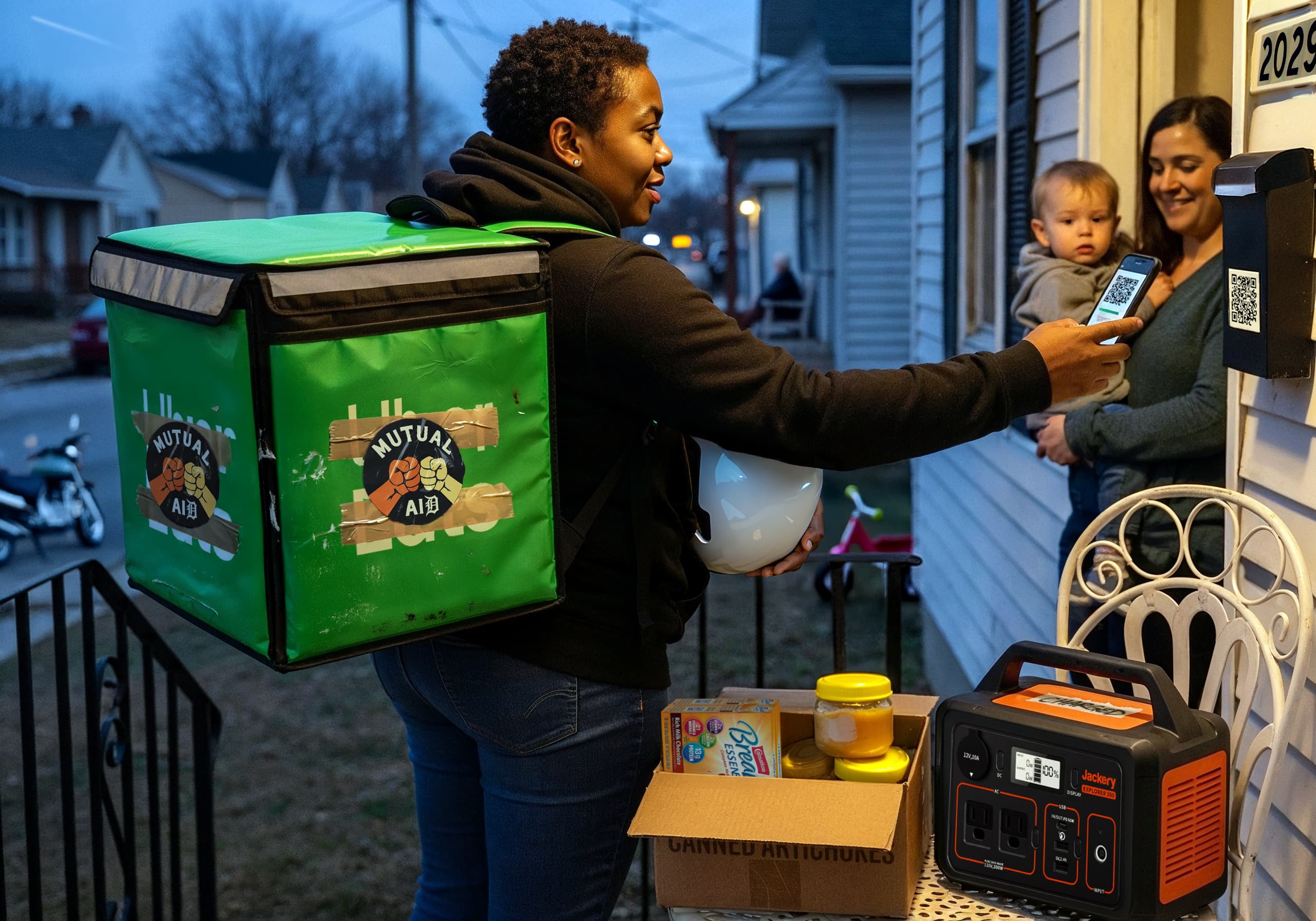
Detroit, Michigan. March 11, 2028
Between their dinner runs, courier Avery Brooks makes an unpaid stop: a box of food, and, more urgently, a charged battery to keep the nebulizer running for Jess’s son on a spare-the-air day. Neighbors like Jess have leaned on the local mutual-aid network’s battery-share microgrid since electricity rates spiked—a rise widely linked to the One Big Beautiful Bill; in the last two years, the typical household is paying about $110 more a year for power. Mutual-aid networks nationwide are stretched thin: they can bridge a night, but they can’t replace a fundamentally fraying safety net.
Sources
- "The One Big ‘Beautiful’ Bill’s SNAP Cuts Would Strain Food Banks Amid Rising Food Insecurity" — Center for American Progress, June 26, 2025
- "Updated: Economic Impacts of U.S. Senate-Passed ‘One Big Beautiful Bill Act’ Energy Provisions" — Energy Innovation, July 1, 2025
- “Trump’s Big Bill Would Be More Regressive Than Any Major Law in Decades” — New York Times, June 12, 2025
About the project
One Big Beautiful Aftermath: Dispatches from Near-Future America is a vital work of speculative journalism that examines the human consequences of sweeping policy change. Using the unflinching lens of photojournalism to illustrate widely-anticipated impacts, the project depicts ten scenes of everyday Americans striving and struggling in the coming years with more friction, deeper uncertainty, and diminished support systems in a country reshaped by the One Big Beautiful Bill Act (OBBBA), the "mega-bill" legislation passed by Congress and signed into law in July 2025.
Each dispatch grounds abstract policy in lived reality: a teacher stocking a classroom pantry for hungry students, a Marine veteran documenting work hours to keep food benefits, a medical school acceptance letter that arrives with an impossible price tag, a child doing homework during his afterschool fast food job. These scenes make tangible what budget provisions and legislative text cannot: the transformation of line-item cuts into 10-year-old breadwinners and families foraging for food.
The project emerged from a core observation: few Americans fully understood the sweeping policy changes in the One Big Beautiful Bill Act before its passage. As awareness has grown, so has opposition to the bill's specific provisions. The OBBBA now stands as the most unpopular piece of American legislation in decades. Yet even now, millions still struggle to anticipate its concrete effects. Aftermath bridges that gap between opinion and understanding by making distant repercussions feel immediate and personal.
Methodologically, Aftermath is speculative journalism—an emerging form of reporting that investigates probable futures with the rigor of traditional journalism, the tools of strategic foresight, and the creativity and accessibility of speculative design. While speculative, every scene draws from a consensus of expert analyses—from government agencies to think tanks to advocacy groups across the political spectrum—about the OBBBA's likely impacts. The images themselves, created using generative AI combined with hundreds of hours of meticulous refinement, aim for the visual credibility of photojournalism while maintaining transparency about their constructed nature. Like data journalism or investigative journalism before it, speculative journalism expands what journalism can be in an era that demands we grasp the futures unfolding in real-time.
One Big Beautiful Aftermath follows Insurrection: An American Future, published in January 2025, which depicts the deployment of federalized troops to American cities under the Insurrection Act—a scenario many dismissed as implausible. Five months later, President Trump deployed National Guard and Marine units into Los Angeles, followed by orders for federal forces to Washington D.C., Chicago, Memphis, and Portland. While predictive accuracy isn't the measure of valuable foresight—plausible futures merit serious consideration regardless of whether they occur—Insurrection's validated predictions demonstrate the power of rigorous research and expert consensus to identify the futures most worth preparing for. Aftermath applies this same methodology to the long-term human costs of the One Big Beautiful Bill, translating technical analysis into visceral, accessible human stories. In an era of relentless, unprecedented disruption, this approach helps people see beyond the barrage of headlines to grasp what those headlines actually mean.
Speculative journalism serves a critical function in an accelerating present: it creates space for understanding and debate about policy impacts before those impacts become irreversible. When norms shatter daily and government actions upend millions of lives faster than traditional journalism can document their effects, we need new forms of reporting and storytelling that illuminate tomorrow's realities with today's urgency. One Big Beautiful Aftermath doesn't predict the future—it reports on a future likely to emerge, helping us to see what's unfolding while there's still time to change course.
About the creator
Jason Tester is a strategic futurist and speculative designer whose work explores the human consequences of political, technological, and social transformation. For over twenty years, he has used visual and immersive storytelling to make abstract future possibilities more understandable, accessible, and emotionally resonant for diverse audiences.
Tester has been a leading figure in the field of speculative design since the practice began to take shape. At the Institute for the Future in Palo Alto, where he served as research director for a decade, Tester helped lead the organization's experimentation with and transition to new media and narrative formats. His work has encompassed hundreds of "artifacts from the future"—what-if postcards, news broadcasts, product prototypes, and first-person accounts that reflect an array of emerging technologies, social phenomena, and cultural shifts. These creations have enabled organizations, governments, and communities to viscerally experience the futures their decisions might create.
Most recently, Tester has incorporated generative AI tools into his practice which, combined with decades of experience as a digital illustrator, enable him to prototype future worlds, alternate histories, and parallel realities with unprecedented complexity and visual fidelity. Tester is a fierce advocate for democratizing futurism—expanding whose ideas about the future get heard and making the creation of compelling speculative narratives accessible beyond corporate and institutional settings.
Based in San Francisco for over two decades, and deeply rooted in the city's LGBTQ+ community, Tester brings both place and identity into his creative practice. His work often reflects the realities and resilience of groups that sit outside centers of power—particularly cultures that have long been forced to think ahead, adapt quickly, and build futures for themselves when no one else would. This perspective informs his belief that speculative work should serve those most vulnerable to policy change, making abstract threats concrete before they become irreversible.
Tester holds degrees in Interaction Design from Stanford University and the Interaction Design Institute in Ivrea, Italy. His work and perspectives have appeared in the New York Times, Wall Street Journal, WIRED, and on MSNBC and CNN.
Please note: One Big Beautiful Aftermath is a work of speculative journalism. All scenarios, images, and narratives represent researched possibilities rather than predicted certainties. While grounded in documented policy provisions and expert analysis, the work does not claim to forecast specific outcomes. All depicted persons are fictional constructs created to illustrate potential human consequences of policy change.
Feedback appreciated:
Received. Thank you.